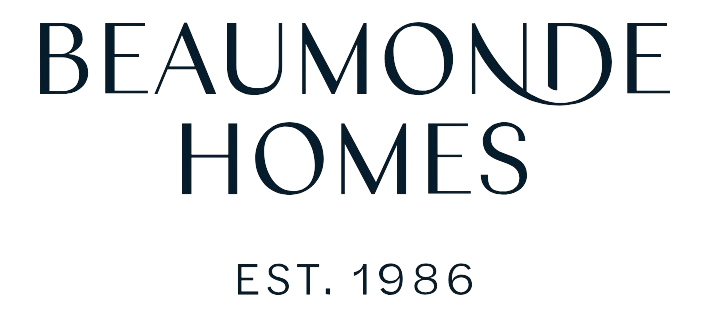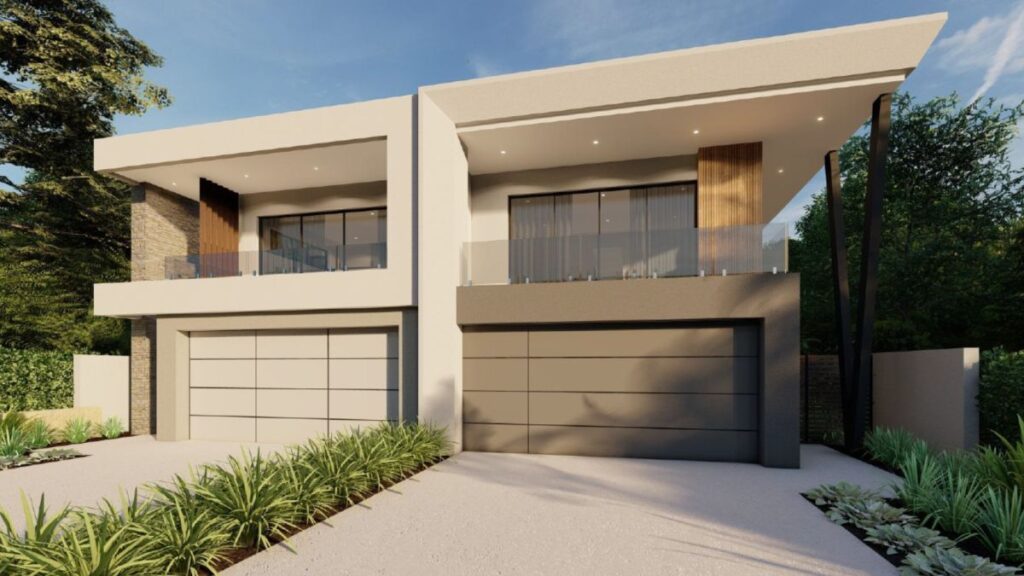Reverse Living Homes
Capture Views And Enhance Your Lifestyle With A Reverse Living Home Design.
Reverse living home designs are revolutionizing the way we think about residential architecture.
Flipping the traditional home layout upside down, by placing living spaces on the upper floors and bedrooms on the lower, reverse living (or upside down homes) offer unique benefits that cater to modern lifestyles.
Moving living areas to the first floor not only maximize views and natural light but also enhance privacy and luxury in everyday living. From personal lifts to wind-protected balconies, these homes often boast luxury inclusions that make reverse living homes not just a dwelling, but a lifestyle choice.
If you’re a homeowner seeking to make the most of your scenic location, this guide to reverse living home designs will provide you with ideas to make your new home both functional and luxurious.
What is a Reverse Living or Upside Down House?
The Definition of Reverse Living Homes
Reverse living, also known as upside-down house or upside down living, inverts the traditional home layout by situating the main living areas (kitchen, living room, dining area and often the master bedroom) on the upper floor and minor bedrooms on the lower floor. This design choice is driven by the desire to maximize views, natural light, and privacy, particularly in scenic or urban environments.
The concept of reverse living has gained popularity in contemporary architecture as homeowners seek to capitalize on their property’s unique features. This could be a city skyline, coastal horizon, or lush hillside. Initially observed in homes built on challenging or sloping terrains where conventional designs were impractical, reverse living has evolved into a deliberate choice for those aiming to enhance their living experience.
Example of a Reverse Living Floor Plan
This floor plan is a three storey home designed by Beaumonde Homes. Designed to suit a narrow block with ocean views, this wonderful home includes a personal lift conveniently positioned near the garage entry to assist traversing between levels.
The middle floor features the primary living zones and includes the open plan Kitchen, Meals and Living zone, extending out to the large rear balcony. A third level caters for a luxurious master suite with its very own private balcony.
Ground Floor

Middle Floor

Top Floor

The Benefits of Reverse Living
By placing living spaces on the upper floors, residents enjoy unobstructed views that might be blocked on lower levels due to neighbouring buildings or natural obstructions. This elevation also allows for greater natural light, reducing the reliance on artificial lighting during the day and creating a more vibrant and inviting atmosphere.
Enhancing Privacy in Urban Environments
In densely populated areas, privacy can be a significant concern. Reverse living elevates the most frequently used areas of the home away from street level and prying eyes, offering a secluded retreat without the need for heavy curtains or blinds.
Better Utilization of Sloping and Unique Blocks
Sloping blocks, often seen as a challenge for traditional home designs, are ideal for reverse living. This approach allows homeowners to take full advantage of their land’s natural contours, integrating the home seamlessly with its environment and often reducing construction costs associated with extensive land leveling.
See our guide on sloping block home designs if you have a sloping block.
2 Storey ‘U’ Shaped Reverse Living Home Plans
This floor plan by Beaumonde Homes shows how clever design creates an internal courtyard forming a ‘U’ shape design on a narrow block, reverse living 2 storey home. The ground floor caters for the minor bedrooms, a Theatre room as well as a separate Games room which has access to the back yard Alfresco and swimming pool.
The second floor is accessed by the stairwell or personal lift and features the main living areas towards the front of the home with a large, wind protected balcony to enjoy views. Also on the second floor is the large master suite with oversized dressing area, ensuite and two small wind protected balconies.
This design really highlights how reverse living can enhance livibility. The balconies upstairs allow extra space, but also excellent cross ventillation throughout the whole upper floor. The U shaped design creates a natural central courtyard and light well, allowing natural light to stream into the home on both levels.
Ground Floor

Second Floor

Design Considerations for Reverse Living Homes
Site Analysis and Orientation
Successful reverse living designs start with a thorough site analysis, considering factors like the direction of sunlight, prevailing winds, and the best angles for views. Orientation plays a critical role in maximizing the benefits of reverse living, ensuring that living spaces enjoy optimal light and vistas.
Did you know we offer free site inspection and analysis?
If you’re looking for a custom home design to capture views, then reverse living might be just right for you.
Our site inspection is a great way for our design team to assess your block and see what views are available. This helps us shape your home design so you can enjoy the views for years to come.
Simply complete the form on this page to request yours today.
Balancing Aesthetics with Functionality
While the allure of views and light is compelling, it’s crucial to balance these with functional design choices. This includes considering how the home’s layout will facilitate daily routines, the flow between indoor and outdoor spaces, and how each area will be used throughout the day.
Navigating Building Regulations and Codes
Building a reverse living home may involve unique regulatory considerations, particularly in areas with strict zoning laws or building codes. Early consultation with local authorities and professionals can help identify any potential hurdles and ensure the design complies with all requirements.
Fortunately our design team has decades of experience designing to the R-Codes and in line with local council planning requirements. This ensures our designs aren’t delayed during the approvals process, meaning you begin building faster.
Reverse Living Styles
Design a house you’ll love coming home to.
These side by side reverse living narrow lot homes complement each other by using similar materials, while having their own personality.
With every home we design, we consider the location, the character of the street and our clients personal style preferences. Guiding clients on architectural shapes, lines, materials and colours is one of our specialities.
No matter what style of home you prefer, be it modern, hamptons, mediterranean, art-deco, colonial or any other style, we’ve designed it and built it.
Speak to us today and discover how designing, building and living in a Beaumonde Home is a wonderful experience you’ll cherish for many years to come.
Luxury Inclusions for Comfort and Livability
Personal Lifts: Elevating Convenience and Accessibility
In reverse living designs, personal lifts are not just a luxury but a practical inclusion that enhances accessibility between floors. This feature is particularly beneficial for families with elderly members or those with mobility issues, ensuring the home is comfortable and accessible for everyone. Besides, lifts can add a sophisticated touch to the property, increasing its market value.
Ageing in place is also growing in awareness and demand which means adding the provision for a future lift is often a wise choice for potential future resale value.
Wind-Protected Balconies: Enjoying the Outdoors in Comfort
One of the joys of reverse living is the ability to seamlessly connect with outdoor spaces. Wind-protected balconies and terraces ensure that residents can enjoy panoramic views and fresh air without the discomfort of strong winds, making these areas usable year-round. Strategic design elements, such as glass balustrades or adjustable louvres, can provide protection while maximizing views.
Optimizing Natural Light Without Overshadowing
Maximizing natural light on the upper floor, where living areas are located, can be achieved without suffering from overshadowing by neighboring houses. Clever design techniques, such as skylights, strategically placed windows, and reflective surfaces, lightwells and more… ensure that these spaces are bright and airy, promoting a sense of well-being and reducing energy consumption.
Smart Home Features for Modern Living
Integrating smart home technology in reverse living designs enhances comfort, security, and efficiency. Features like automated blinds, climate control, and lighting systems can be controlled remotely, ensuring that the living environment is always welcoming. Smart security systems provide peace of mind, while energy management systems contribute to a sustainable lifestyle.
Creating Functional and Stylish Living Spaces
Open-Plan Living Areas with a View
The hallmark of reverse living is the open-plan living area that offers expansive views. This design encourages social interaction and makes the most of the home’s location. To enhance the sense of space, use minimalistic design elements, neutral color palettes, and natural materials that reflect light and add warmth.
Integrating Indoor and Outdoor Spaces
Bi-fold or sliding doors can create a seamless transition between indoor living areas and outdoor balconies or terraces. This not only extends the living space but also allows for an alfresco dining experience, entertaining, or simply relaxing with the backdrop of a stunning view. Incorporating outdoor kitchens or BBQ areas further enhances this integration.
Material and Color Choices to Enhance Light and Space
Choosing the right materials and colors is crucial in reverse living designs to enhance natural light and the perception of space. Light-colored walls, reflective surfaces, and glass features can amplify light, while natural wood, stone, and textiles add texture and warmth, creating inviting and comfortable living areas.
Bedroom and Private Area Design on the Lower Floor
Ensuring Quiet and Restful Bedrooms
Positioning bedrooms on the lower floor can provide a sanctuary away from the main living areas. To enhance tranquillity, Beaumonde Homes builds with concrete suspended slabs. This reduces most of the noise transfer between levels, unlike a timber framed floors which require additional sound proofing (and even then it can struggle to compete with concrete). If you’ve ever been in a timber framed home you may have experienced hearing the flushing toilet running through the pipes in the ceiling space (the floor cavity above). Something we’d prefer to avoid which is why concrete is our preference.
Bedrooms can also have direct access to private gardens or courtyards, offering a serene retreat.
Private Gardens and Outdoor Access
Creating private outdoor spaces accessible from bedrooms adds value to reverse living homes. Landscaped gardens, patios, or small decks can serve as private extensions of the bedroom, perfect for morning coffee or quiet contemplation. These areas can be designed with privacy in mind, using screening plants or architectural features.
Incorporating Natural Light and Ventilation
Even though bedrooms are on the lower floor, ensuring ample natural light and ventilation is essential. Consider well-placed windows, light wells, or courtyard designs that allow light to penetrate while maintaining privacy. Effective ventilation strategies will ensure these spaces remain fresh and comfortable throughout the year.
Case Studies: Successful Reverse Living Designs
Urban Homes with Panoramic Cityscapes or Parkland Views
In bustling cities, where space is at a premium and privacy is coveted, a reverse living designs shine. A notable example would be a home in a dense urban area that maximizes its narrow lot by extending living spaces upwards, offering sweeping views of a city skyline or perhaps a coveted parkland view.
An open-plan living area on the top floor can feature floor-to-ceiling windows, drawing in natural light and creating a visual connection with the urban landscape. Strategic placement of bedrooms on the lower level can ensure a quiet, secluded retreat from the city’s hustle and bustle.
Coastal Retreats with Uninterrupted Sea Views
A coastal home designed with reverse living principles can take full advantage of its seaside location. Designing the upper floor living area to open onto a spacious balcony with glass railings, providing unobstructed views of the ocean.
A coast home design should also incorporate weather-resistant materials and wind protection features, ensuring the outdoor space is comfortable year-round.
Bedrooms on the ground floor can have direct access to a landscaped garden and path leading to the beach, emphasizing a strong indoor-outdoor connection.
Hillside Havens Maximizing Sloping Terrain
In a home built on a challenging hillside block, reverse living allows for a unique adaptation to the terrain.
The top floor, housing the main living areas, can be designed with expansive windows and an elevated deck to capture panoramic views of the surrounding hills and valleys.
The lower level, embedded into the slope through an undercroft garage, provides a cool and quiet sleeping environment for bedrooms and secondary living zones.
A home design like this can utilise the natural incline for drainage and minimizes the need for extensive excavation, showcasing how reverse living can turn topographical challenges into advantages.
MORE TESTIMONIALS
Challenges and Solutions in Reverse Living Design
Addressing Structural and Engineering Considerations
The unique configuration of reverse living homes can introduce specific structural challenges, such as the need for additional support for upper-level living spaces and heavy-duty windows to withstand wind on elevated floors, especially those by the coast.
Solutions might include employing advanced engineering techniques and materials, such as additional steel tie-downs in the roof space and high-performance glazing for energy efficiency and weather resistance.
Weatherproofing and Energy Efficiency Strategies
Ensuring the upper living areas are comfortable in all weather conditions requires thoughtful design. This can include incorporating overhangs or awnings to shield from the sun, using high-quality insulation to maintain temperature, and selecting energy-efficient heating and cooling systems tailored to the home’s layout.
Custom Solutions for Unique Site Challenges
Every site has its own set of challenges, whether it’s a steep slope, limited access, or strict zoning regulations. Tailoring the design to address these issues is key to a successful reverse living home. For example, on a very steep site, the design might include terraced outdoor spaces connected to the lower bedrooms to provide private outdoor areas that work with the natural landscape. Engaging with local authorities early in the design process can also help navigate any regulatory challenges and ensure the project meets all local codes and standards.
The Future of Reverse Living Designs
Trends in Architecture and Design
The future of reverse living designs looks promising, with trends favoring homes that prioritize views, natural light, and the integration of indoor and outdoor spaces. Innovations in materials and construction technologies are making it easier and more cost-effective to implement reverse living features, such as large expanses of glass for better views and advanced insulation techniques for energy efficiency. As urban areas become denser and privacy becomes more precious, the demand for homes that offer a sanctuary above the fray is expected to rise.
Sustainability and Eco-Friendly Innovations
Sustainability is becoming a cornerstone of modern architecture, and reverse living designs are well-positioned to embrace eco-friendly innovations. Features like solar panels, natural ventilation and double glazing are increasingly common in reverse living homes, reducing their environmental footprint while enhancing livability. The orientation and design of these homes often allow for optimal solar gain in winter and natural cooling in summer, aligning with passive house principles and contributing to a more sustainable future.
The Growing Appeal of Upside-Down Living
As more people experience the benefits of reverse living, its appeal is set to grow. The design philosophy caters to a wide range of homeowners, from those seeking to make the most of a stunning view to those valuing privacy and quiet in urban settings. The adaptability of reverse living designs to different sites, whether urban, coastal, or hillside, means they can meet diverse needs and preferences, further fueling their popularity.
Embracing Reverse Living for a Modern Lifestyle
Reverse living designs offer a fresh perspective on home layout, turning traditional architecture on its head to prioritize views, light, and privacy. By situating living areas on the upper floors, these homes provide a unique living experience that connects inhabitants with their surroundings in new and meaningful ways. The inclusion of luxury features like personal lifts, wind-protected balconies, and smart home technology enhances comfort and convenience, making reverse living not just a design choice but a lifestyle one.
As we look to the future, the principles of reverse living—sustainability, connection to nature, and adaptability—align closely with evolving homeowner values. Those considering their next home project would do well to consider the benefits of reverse living, not just for the immediate advantages of views and privacy but for the long-term enjoyment and sustainability of their home.
Embracing reverse living means embracing a modern lifestyle that values innovation, sustainability, and a deep connection to the environment. As this design philosophy continues to evolve, it promises to offer ever more creative and appealing solutions for the homes of tomorrow.
Book your free Site Inspection and Analysis
Speak to us today
If you’re ready to discuss your new home ideas and would like us to inspect your block, simply fill in the contact form and one of our design team will be in contact with you.
This is entirely obligation free and an opportunity for you to ask us any questions you may have regarding the design and construction process.
We look forward to speaking with you soon.
Free Site Inspection & Analysis
Experience the Beaumonde difference
Beaumonde Homes has the positive reputation of designing and building homes that celebrate luxury living. Quality craftsmanship, exquisite finishes and carefully considered design create an atmosphere like no other.
Our dedicated team are here to serve you and ensure every step of your custom home building journey is second to none.



